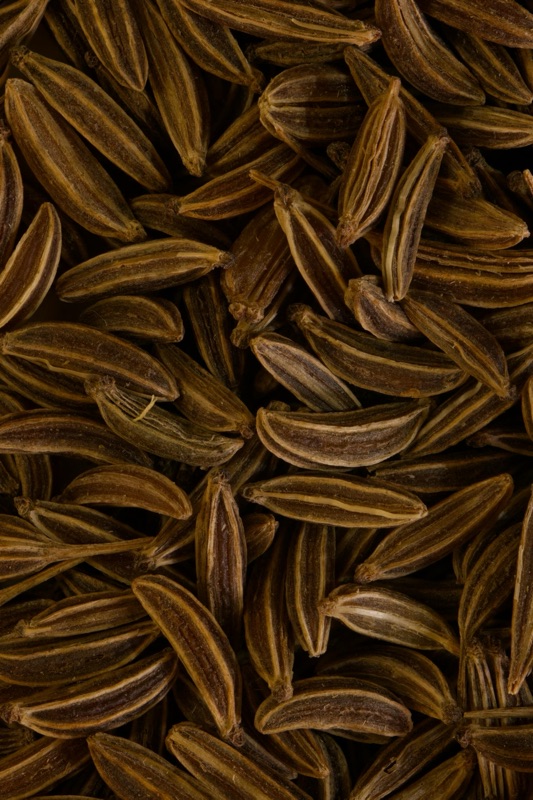Botanical Basics
- Common Name(s): Caraway
- Folk Name(s): Meridian Fennel, Persian Cumin, Karwi, Kummel
- Scientific/Latin Name: Carum carvi
- Family: Apiaceae (Parsley family)
- Plant Type: Biennial herb
- Botanical Description: Grows 1–2 ft tall; feathery, finely divided leaves resemble carrot tops. Small white-to-pink flowers form in umbrella-shaped clusters (umbels). Seeds are crescent-shaped, brown, with ridges, strongly aromatic and flavorful.
- Growing Zones/Climate: USDA Zones 3–7
- Best Zones for Growth: Cooler temperate climates; tolerates short summers and cold winters
- Habitat & Range: Native to Europe, Western Asia, and North Africa; widely cultivated and naturalized worldwide in gardens and fields
Cultivation & Harvest
- Soil & Sun Requirements: Prefers well-drained loamy soil, neutral to slightly alkaline; full sun
- Propagation: By seed, sown directly in spring or autumn; germinates slowly (2–3 weeks)
- Companion Planting: Good companion for peas, cabbages, and potatoes; helps deter pests with aromatic oils
- Harvesting Guidelines: Seeds harvested in second year after flowering; cut seed heads when turning brown, hang to dry, and thresh out seeds
- Drying/Preservation: Seeds dried in a warm, airy place; stored airtight; leaves may also be dried or used fresh
Traditional & Historical Use
- Cultural Significance: Used since the Stone Age; seeds found in Neolithic food remains. Medieval Europe valued it for protecting food from theft and lovers from straying.
- Traditional Medicine: Carminative for digestive complaints, colic, and flatulence; used in lactation teas for nursing mothers.
- Symbolism: Represents fidelity, protection, and banishing of evil spirits.
Medicinal & Practical Properties
- Active Constituents: Volatile oils (carvone, limonene), flavonoids, tannins, fatty acids
- Medicinal Uses:
- Digestive aid (relieves bloating, indigestion, colic)
- Expectorant for coughs and bronchitis
- Galactagogue (stimulates milk flow)
- Mild antimicrobial and spasmolytic
- Preparation Methods: Infusions, tinctures, essential oil (in very small doses), culinary spice
- Dosage & Guidelines:
- Tea: 1 tsp crushed seeds per cup boiling water, up to 3 cups daily
- Tincture: 1–2 mL up to 3 times daily
- Chewed seeds aid digestion after meals
- Safety/Precautions: Generally safe in food/tea amounts. Essential oil is very concentrated—avoid large internal doses. Rare allergies in sensitive individuals.
Magical & Spiritual Properties
- Elemental Association: Air
- Planetary/Deity Correspondence: Mercury; linked to deities of hearth and protection
- Magical Correspondences: Protection, fidelity, anti-theft, healing, banishing negativity
- Ritual Use: Seeds placed in sachets or baked into bread to keep love true; sprinkled around home for protection; burned in incense for banishing
- Symbolism in Divination/Dreams: Suggests protection from deceit, strengthening of bonds, or a call to simplify life
Ecological & Culinary Uses
- Pollinator Value: Umbel flowers attract bees, wasps, and beneficial predatory insects
- Wildlife Uses: Seeds provide food for birds; foliage occasionally browsed by herbivores
- Culinary Uses: Seeds flavor rye bread, cheeses, sauerkraut, soups, stews, and liqueurs; leaves used as a mild herb like parsley; roots edible like parsnips
Household/Practical Uses
- Quick Uses: Chewed seeds for digestion; spice for bread, cheese, and liquors; protective charm
- Notable Traits: One of the oldest cultivated herbs in Europe; both food and medicine; folklore herb of fidelity
- Special Notes: Strong link to kitchen witchcraft traditions—where healing and nourishment meet protection magic

Supporting Notes
- Grieve, M. A Modern Herbal (1931)
- Chevallier, Andrew. Encyclopedia of Herbal Medicine (2016)
- Duke, James A. Handbook of Medicinal Herbs (2002)
- Foster, Steven & Duke, James A. Peterson Field Guide to Medicinal Plants and Herbs
- Rätsch, Christian. Encyclopedia of Herbs and Spices (2005)
No comments:
Post a Comment